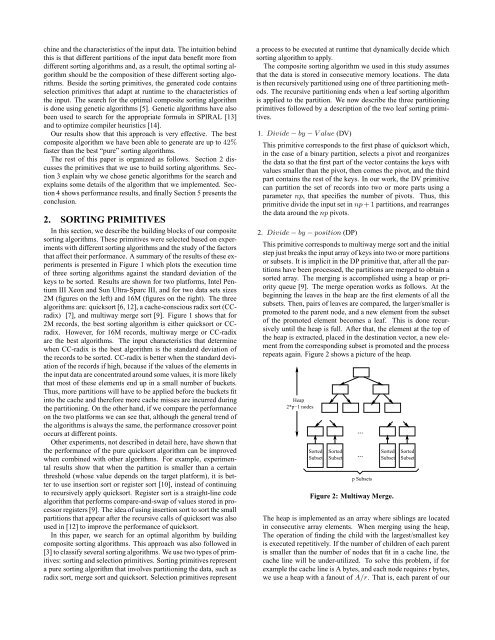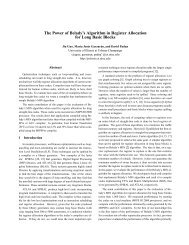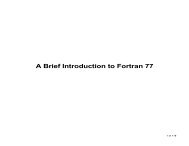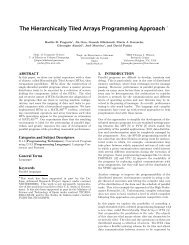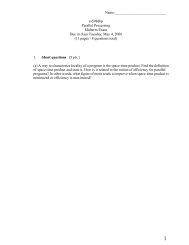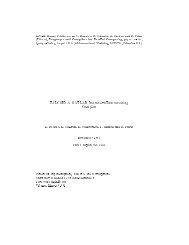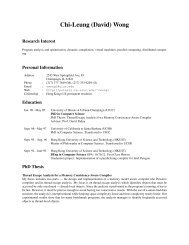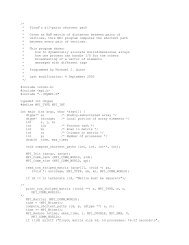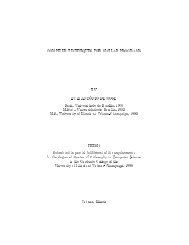Optimizing Sorting with Genetic Algorithms - Polaris
Optimizing Sorting with Genetic Algorithms - Polaris
Optimizing Sorting with Genetic Algorithms - Polaris
Create successful ePaper yourself
Turn your PDF publications into a flip-book with our unique Google optimized e-Paper software.
chine and the characteristics of the input data. The intuition behind<br />
this is that different partitions of the input data benefit more from<br />
different sorting algorithms and, as a result, the optimal sorting algorithm<br />
should be the composition of these different sorting algorithms.<br />
Beside the sorting primitives, the generated code contains<br />
selection primitives that adapt at runtime to the characteristics of<br />
the input. The search for the optimal composite sorting algorithm<br />
is done using genetic algorithms [5]. <strong>Genetic</strong> algorithms have also<br />
been used to search for the appropriate formula in SPIRAL [13]<br />
and to optimize compiler heuristics [14].<br />
Our results show that this approach is very effective. The best<br />
composite algorithm we have been able to generate are up to 42%<br />
faster than the best “pure” sorting algorithms.<br />
The rest of this paper is organized as follows. Section 2 discusses<br />
the primitives that we use to build sorting algorithms. Section<br />
3 explain why we chose genetic algorithms for the search and<br />
explains some details of the algorithm that we implemented. Section<br />
4 shows performance results, and finally Section 5 presents the<br />
conclusion.<br />
2. SORTING PRIMITIVES<br />
In this section, we describe the building blocks of our composite<br />
sorting algorithms. These primitives were selected based on experiments<br />
<strong>with</strong> different sorting algorithms and the study of the factors<br />
that affect their performance. A summary of the results of these experiments<br />
is presented in Figure 1 which plots the execution time<br />
of three sorting algorithms against the standard deviation of the<br />
keys to be sorted. Results are shown for two platforms, Intel Pentium<br />
III Xeon and Sun Ultra-Sparc III, and for two data sets sizes<br />
2M (figures on the left) and 16M (figures on the right). The three<br />
algorithms are: quicksort [6, 12], a cache-conscious radix sort (CCradix)<br />
[7], and multiway merge sort [9]. Figure 1 shows that for<br />
2M records, the best sorting algorithm is either quicksort or CCradix.<br />
However, for 16M records, multiway merge or CC-radix<br />
are the best algorithms. The input characteristics that determine<br />
when CC-radix is the best algorithm is the standard deviation of<br />
the records to be sorted. CC-radix is better when the standard deviation<br />
of the records if high, because if the values of the elements in<br />
the input data are concentrated around some values, it is more likely<br />
that most of these elements end up in a small number of buckets.<br />
Thus, more partitions will have to be applied before the buckets fit<br />
into the cache and therefore more cache misses are incurred during<br />
the partitioning. On the other hand, if we compare the performance<br />
on the two platforms we can see that, although the general trend of<br />
the algorithms is always the same, the performance crossover point<br />
occurs at different points.<br />
Other experiments, not described in detail here, have shown that<br />
the performance of the pure quicksort algorithm can be improved<br />
when combined <strong>with</strong> other algorithms. For example, experimental<br />
results show that when the partition is smaller than a certain<br />
threshold (whose value depends on the target platform), it is better<br />
to use insertion sort or register sort [10], instead of continuing<br />
to recursively apply quicksort. Register sort is a straight-line code<br />
algorithm that performs compare-and-swap of values stored in processor<br />
registers [9]. The idea of using insertion sort to sort the small<br />
partitions that appear after the recursive calls of quicksort was also<br />
used in [12] to improve the performance of quicksort.<br />
In this paper, we search for an optimal algorithm by building<br />
composite sorting algorithms. This approach was also followed in<br />
[3] to classify several sorting algorithms. We use two types of primitives:<br />
sorting and selection primitives. <strong>Sorting</strong> primitives represent<br />
a pure sorting algorithm that involves partitioning the data, such as<br />
radix sort, merge sort and quicksort. Selection primitives represent<br />
a process to be executed at runtime that dynamically decide which<br />
sorting algorithm to apply.<br />
The composite sorting algorithm we used in this study assumes<br />
that the data is stored in consecutive memory locations. The data<br />
is then recursively partitioned using one of three partitioning methods.<br />
The recursive partitioning ends when a leaf sorting algorithm<br />
is applied to the partition. We now describe the three partitioning<br />
primitives followed by a description of the two leaf sorting primitives.<br />
1. Divide − by − Value(DV)<br />
This primitive corresponds to the first phase of quicksort which,<br />
in the case of a binary partition, selects a pivot and reorganizes<br />
the data so that the first part of the vector contains the keys <strong>with</strong><br />
values smaller than the pivot, then comes the pivot, and the third<br />
part contains the rest of the keys. In our work, the DV primitive<br />
can partition the set of records into two or more parts using a<br />
parameter np, that specifies the number of pivots. Thus, this<br />
primitive divide the input set in np +1partitions, and rearranges<br />
the data around the np pivots.<br />
2. Divide − by − position (DP)<br />
This primitive corresponds to multiway merge sort and the initial<br />
step just breaks the input array of keys into two or more partitions<br />
or subsets. It is implicit in the DP primitive that, after all the partitions<br />
have been processed, the partitions are merged to obtain a<br />
sorted array. The merging is accomplished using a heap or priority<br />
queue [9]. The merge operation works as follows. At the<br />
beginning the leaves in the heap are the first elements of all the<br />
subsets. Then, pairs of leaves are compared, the larger/smaller is<br />
promoted to the parent node, and a new element from the subset<br />
of the promoted element becomes a leaf. This is done recursively<br />
until the heap is full. After that, the element at the top of<br />
the heap is extracted, placed in the destination vector, a new element<br />
from the corresponding subset is promoted and the process<br />
repeats again. Figure 2 shows a picture of the heap.<br />
Heap<br />
2*p−1 nodes<br />
...<br />
Sorted Sorted<br />
Sorted Sorted<br />
...<br />
Subset Subset Subset Subset<br />
p Subsets<br />
Figure 2: Multiway Merge.<br />
The heap is implemented as an array where siblings are located<br />
in consecutive array elements. When merging using the heap,<br />
The operation of finding the child <strong>with</strong> the largest/smallest key<br />
is executed repetitively. If the number of children of each parent<br />
is smaller than the number of nodes that fit in a cache line, the<br />
cache line will be under-utilized. To solve this problem, if for<br />
example the cache line is A bytes, and each node requires r bytes,<br />
we use a heap <strong>with</strong> a fanout of A/r. That is, each parent of our


